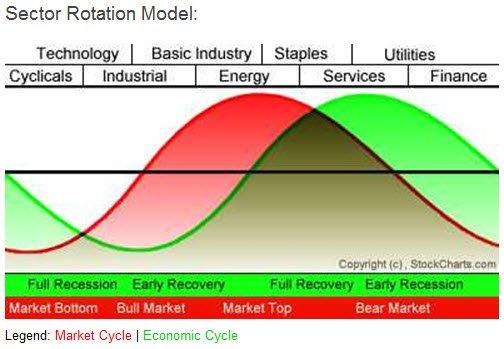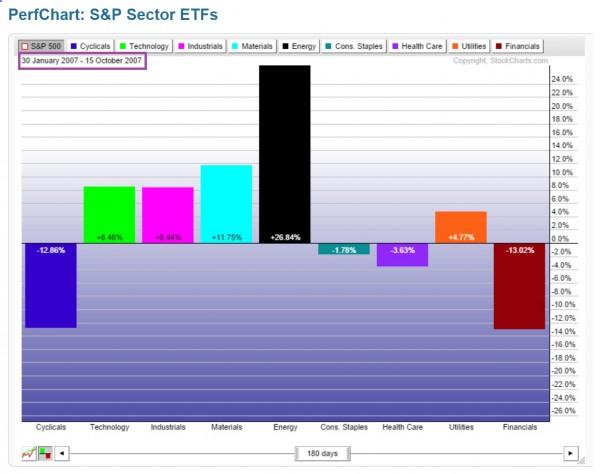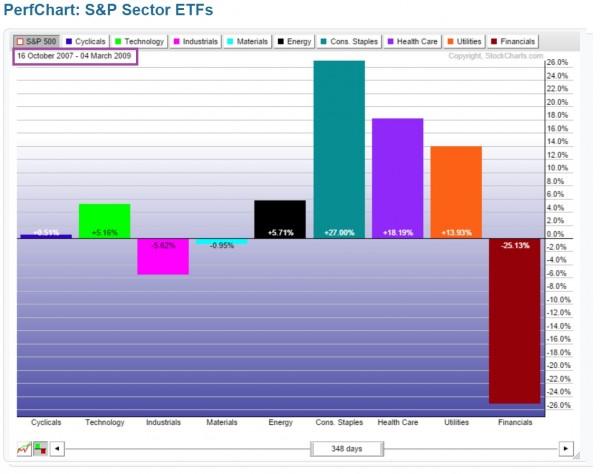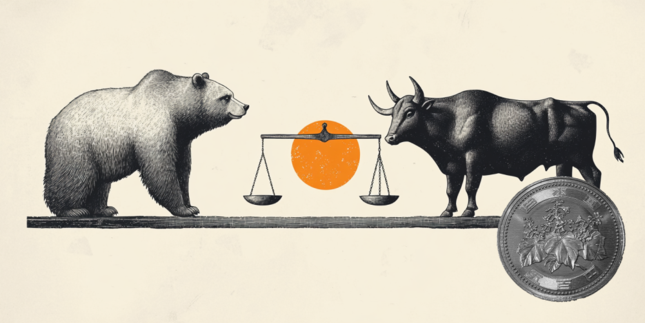Choosing which stock to trade is always a challenge. There are many screeners available either free or for a small subscription fee. While they can be helpful, another simple technique can be even better in narrowing your selection process and may even offer insight as to when the markets may start to turn themselves.
Markets go through a rotation that is common throughout the world. All modern capitalistic economies work in similar manners and I have applied this analysis with great success to the US, Singapore, European, UK, and Indian equity markets. Let’s face it – we are all people, driven by the same forces of fear and greed when playing in the markets. These emotions make our investing and trading very predictable.
The stock market itself can be a leading indicator for the economy as investors place their money into “safe” sectors that they believe will outperform giving the future outlook of the economy. If you look at the chart below, you can see how the market cycle in red tends to lead the economic cycle in green by approximately three months. This makes sense when you think of how the markets turned downward in October 2007, well before the announcement that the United States and the rest of the world had entered into the 2008 recession.
Choosing which stock to trade is always a challenge. There are many screeners available either free or for a small subscription fee. While they can be helpful, another simple technique can be even better in narrowing your selection process and may even offer insight as to when the markets may start to turn themselves.
Markets go through a rotation that is common throughout the world. All modern capitalistic economies work in similar manners and I have applied this analysis with great success to the US, Singapore, European, UK, and Indian equity markets. Let’s face it – we are all people, driven by the same forces of fear and greed when playing in the markets. These emotions make our investing and trading very predictable.
The stock market itself can be a leading indicator for the economy as investors place their money into “safe” sectors that they believe will outperform giving the future outlook of the economy. If you look at the chart below, you can see how the market cycle in red tends to lead the economic cycle in green by approximately three months. This makes sense when you think of how the markets turned downward in October 2007, well before the announcement that the United States and the rest of the world had entered into the 2008 recession.
When there is danger on the horizon for the economy and markets, money will start to flow into sectors viewed as “safe havens.” Consumer Staples, Healthcare and Services and Utilities are examples of those safe investmenthaven sectors. The staples and healthcare are things we as a society still spend money on even if the economy starts to slump. Brokers advise their clients to protect their capital and you will see those sectors hold steady or even start to rise when danger appears or economic slowdown is imminent.
The utility sector is one that benefits in two ways from a bear market. First, this sector tends to pay out larger dividends than stocks in other sectors, so those seeking dividend yield are smart to invest here. Secondly, utility companies are usually operating on high debt having issued bonds to finance operations. If the economy is slumping, the Federal Reserve will lower interest rates as a move to stimulate it. The lower interest rate allows the utility company to re-issue new bonds at lower rates to pay off older, higher rate debt. This frees up money for them and increases profitability.
The last sector, Financials, also benefits from lower interest rates. In a lower interest rate environment, money can be borrowed for expanding business operations and consumer purchases to stimulate the economy. When businesses and investors think the end of the recession or slowdown is near, they will start to place money into financial stocks causing them to lead the markets out of the bearish mode.
This is a longer term cycle that could take four to eight years to complete and is therefore, more suited for investors or swing traders looking for signals or an advantage in trading. However, when you are an intraday trader, knowledge of this rotation can also be beneficial. On a day where the markets are bullish, the rotation model can tell you which sectors are best poised to move further in that direction thus improving your returns. The same is true for bearish market days.
So the big question on most investors’ and traders’ minds is whether the current market environment is going to continue to seek new highs or is primed for a crash. There is no doubt that the markets are overbought and valuations of many securities are extremely high. We can look to see what the sector rotation tells us about where those investors and traders expect both the markets and economy to head.
Looking at the sector rotation over the last six months, there has definitely been a shift into some of the “safety sectors” for investments. This would indicate that the markets are afraid of an imminent correction or crash coming. Should this trend continue, I would not be surprised to see the markets drop during the summer of this year
To learn more, I invite you to speak to an Education Counselor at our Online Trading Academy offices and enroll in our Professional Trader Course, and then to continue your education by joining the Extended Learning Track (XLT) program where we learn to identify the sector rotation using simple tools and analysis and many other techniques for improving your chances for trading success.
Neither Freedom Management Partners nor any of its personnel are registered broker-dealers or investment advisers. I will mention that I consider certain securities or positions to be good candidates for the types of strategies we are discussing or illustrating. Because I consider the securities or positions appropriate to the discussion or for illustration purposes does not mean that I am telling you to trade the strategies or securities. Keep in mind that we are not providing you with recommendations or personalized advice about your trading activities. The information we are providing is not tailored to any individual. Any mention of a particular security is not a recommendation to buy, sell, or hold that or any other security or a suggestion that it is suitable for any specific person. Keep in mind that all trading involves a risk of loss, and this will always be the situation, regardless of whether we are discussing strategies that are intended to limit risk. Also, Freedom Management Partners’ personnel are not subject to trading restrictions. I and others at Freedom Management Partners could have a position in a security or initiate a position in a security at any time.
Editors’ Picks

EUR/USD accelerates losses to 1.0930 on stronger Dollar
The US Dollar's recovery regains extra impulse sending the US Dollar Index to fresh highs and relegating EUR/USD to navigate the area of daily troughs around 1.0930 in the latter part of Friday's session.

GBP/USD plummets to four-week lows near 1.2850
The US Dollar's rebound keep gathering steam and now sends GBP/USD to the area of multi-week lows in the 1.2850 region amid the broad-based pullback in the risk-associated universe.

Gold trades on the back foot, flirts with $3,000
Gold prices are accelerating their daily decline, steadily approaching the critical $3,000 per troy ounce mark as the Greenback's rebound gains extra momentum and US yields tighten their retracement.

Can Maker break $1,450 hurdle as whales launch buying spree?
Maker holds steadily above $1,250 support as a whale scoops $1.21 million worth of MKR. Addresses with a 100k to 1 million MKR balance now account for 24.27% of Maker’s total supply. Maker battles a bear flag pattern as bulls gather for an epic weekend move.

Strategic implications of “Liberation Day”
Liberation Day in the United States came with extremely protectionist and inward-looking tariff policy aimed at just about all U.S. trading partners. In this report, we outline some of the more strategic implications of Liberation Day and developments we will be paying close attention to going forward.
RECOMMENDED LESSONS
Making money in forex is easy if you know how the bankers trade!
Discover how to make money in forex is easy if you know how the bankers trade!
5 Forex News Events You Need To Know
In the fast moving world of currency markets, it is extremely important for new traders to know the list of important forex news...
Top 10 Chart Patterns Every Trader Should Know
Chart patterns are one of the most effective trading tools for a trader. They are pure price-action, and form on the basis of underlying buying and...
7 Ways to Avoid Forex Scams
The forex industry is recently seeing more and more scams. Here are 7 ways to avoid losing your money in such scams: Forex scams are becoming frequent. Michael Greenberg reports on luxurious expenses, including a submarine bought from the money taken from forex traders. Here’s another report of a forex fraud. So, how can we avoid falling in such forex scams?
What Are the 10 Fatal Mistakes Traders Make
Trading is exciting. Trading is hard. Trading is extremely hard. Some say that it takes more than 10,000 hours to master. Others believe that trading is the way to quick riches. They might be both wrong. What is important to know that no matter how experienced you are, mistakes will be part of the trading process.

The Best brokers to trade EUR/USD
SPONSORED Discover the top brokers for trading EUR/USD in 2025. Our list features brokers with competitive spreads, fast execution, and powerful platforms. Whether you're a beginner or an expert, find the right partner to navigate the dynamic Forex market.




